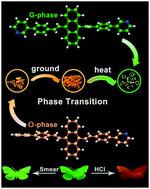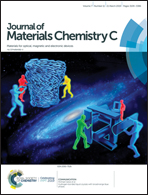Luminescent switching and structural transition through multiple external stimuli based on organic molecular polymorphs†
Abstract
Investigations on the relationship between multi-stimuli responsive luminescent properties and aggregation structures of polymorphs play a crucial role in developing organic multi-stimuli responsive luminescent (OMSRL) materials. Herein, we reported two polymorphs (G-phase and O-phase) based on a novel molecule 9,10-bis-((E)-4-(pyridin-3-yl)styryl)anthracene (BP3SA) and their piezochromic properties, structural transitions, and protonation–deprotonation effects under external stimuli. Photophysical characterization together with the analysis of crystal structures indicated that the G-phase with J-type aggregation showed green emission, while the O-phase with H-type aggregation presented orange emission. Red-shifted emissions could be observed for the two polymorphs under mechanical grinding pressure due to the transition from the crystalline state to the amorphous state. Then upon heating, the ground G-phase could partly recover the initial emission, while the emission of the ground O-phase nearly turned to the initial emission of the G-phase after heating. Powder X-ray diffraction patterns revealed that a structural transition from the O-phase to the G-phase could be achieved by grinding and heating processes. High pressure experiments and theoretical calculations demonstrated that the O-phase showed a more significant red-shift than the G-phase, and the molecular geometry of the O-phase trended toward a more planar conformation than that of the G-phase under the same hydrostatic pressure. It indicated that the O-phase had higher sensitivity to the hydrostatic pressure than the G-phase because of the different intermolecular interactions inside the two crystalline phases. Additionally, the protonation–deprotonation of the two polymorphs showed that acid stimuli could induce red-shifted emission, while the emission partly recovered to the initial emission by alkali stimuli due to the change of the intermolecular interactions.

- This article is part of the themed collection: 2019 Journal of Materials Chemistry C HOT Papers


 Please wait while we load your content...
Please wait while we load your content...